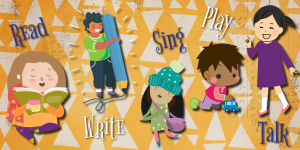
Children are never too young to start making reading a habit, and you are their first role model. If your child sees you reading and enjoying books, they are more likely to be motivated to read. When reading to your child, emphasize quality over quantity. Bite-sized reading sessions that you and your kids enjoy are far better than drawn out reading sessions that become a chore.
Babies
- Start out with board books and let your baby handle the book. Babies will chew on books, shake them around, and turn the pages. This is normal. They are learning how to handle a book.
- Talk to your baby as you go through the book. “What is that? It’s a puppy! Look at its fluffy fur.” Your baby is listening and absorbing everything you say.
- Babies love to look at faces-especially other babies’ faces. Find books with photos of other babies.
Here are some board books with pictures of babies and animals:
Toddlers
- Make bedtime stories a habit. Your toddler will anticipate choosing the story for the evening and spending time with you.
- Sing the alphabet song together. By learning the names of the letters, your child will have a good foundation when they begin reading in school. The Alphabet Song on YouTube
- Talk about the print you see on a normal day. Look at signs at the grocery store, the park, or street signs. This is building print awareness, which will help your child to understand how important reading is to life.
- Don’t be afraid to use big words and explain their meanings to your child. Children with bigger vocabularies have an easier time when they start to read. It’s easier to read words you already know than ones you have never heard before. Picture books will have many unusual words that do not come up in conversations. Talk about these words!
Some fun picture books to share with your kiddos:
Preschoolers
- Play phonics “I Spy.” Use the sounds of syllables rather than the name of the first letter to help kids recognize syllables.
Example: “I spy with my little eye something that begins with ‘pār’ (sounds like ‘pear’).” Answer: Parrot
Take a look at these books full of fun details!
- Point to the words as you are reading so that your child can follow along.
- Look at different shapes. Talk to your child about how different letters are based on different shapes.
Squares, Hearts, and Triangles:
- Write your child’s name and teach them how to write their name. Talk about what letters make up their name.
-Megan, Children's Team at Kirk-Bear Canyon Library
Sources:
“Six Early Literacy Skills.” Colorado Libraries for Early Literacy.
 Read, Write, Talk, Sing, Play!
Read, Write, Talk, Sing, Play!
Reading helps children understand how text works and positions them to increase their language and literacy skills throughout their lives.
Read more about early literacy and how you can make a difference in your child's life.

